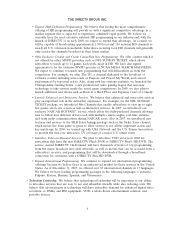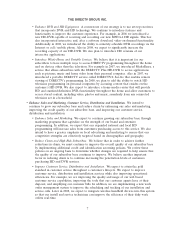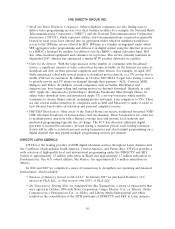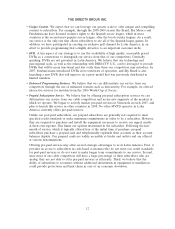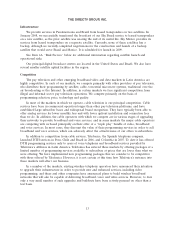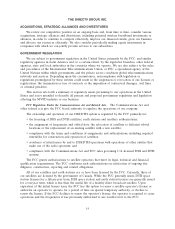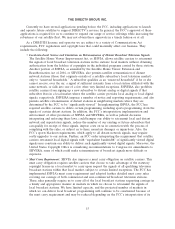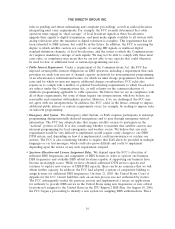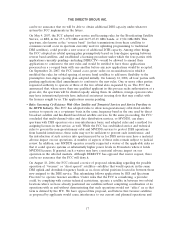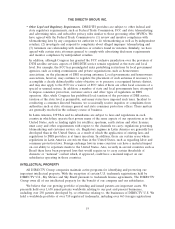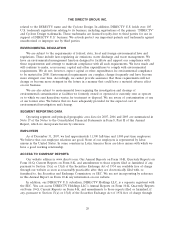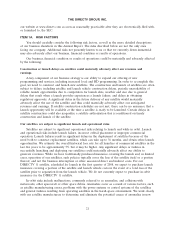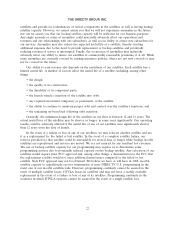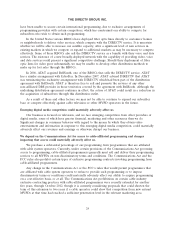DIRECTV 2007 Annual Report Download - page 24
Download and view the complete annual report
Please find page 24 of the 2007 DIRECTV annual report below. You can navigate through the pages in the report by either clicking on the pages listed below, or by using the keyword search tool below to find specific information within the annual report.THE DIRECTV GROUP, INC.
Currently we have several applications pending before the FCC, including applications to launch
and operate future satellites to support DIRECTV’s services. In general, the FCC’s approval of these
applications is required for us to continue to expand our range of service offerings while increasing the
robustness of our satellite fleet. We may not obtain these approvals in a timely fashion or at all.
As a DBS/DTH licensee and operator we are subject to a variety of Communications Act
requirements, FCC regulations and copyright laws that could materially affect our business. They
include the following:
•Local-into-Local Service and Limitation on Retransmission of Distant Broadcast Television Signals.
The Satellite Home Viewer Improvement Act, or SHVIA, allows satellite carriers to retransmit
the signals of local broadcast television stations in the stations’ local markets without obtaining
authorization from the holders of copyrights in the individual programs carried by those stations.
Another portion of SHVIA, as amended by the Satellite Home Viewer Extension and
Reauthorization Act of 2004, or SHVERA, also permits satellite retransmission of distant
network stations (those that originate outside of a satellite subscriber’s local television market)
only to ‘‘unserved households.’’ A subscriber qualifies as an ‘‘unserved household’’ if he or she
cannot receive, over the air, a signal of sufficient intensity from a local station affiliated with the
same network, or falls into one of a few other very limited exceptions. SHVERA also prohibits
satellite carriers from signing up a new subscriber to distant analog or digital signals if that
subscriber lives in a local market where the satellite carrier provides local analog or local digital
signals, respectively. SHVERA imposes a number of notice and reporting requirements, and also
permits satellite retransmission of distant stations in neighboring markets where they are
determined by the FCC to be ‘‘significantly viewed.’’ In implementing SHVIA, the FCC has
required satellite carriers to delete certain programming, including sports programming, from the
signals of certain distant stations. In addition, the FCC’s interpretation, implementation and
enforcement of other provisions of SHVIA and SHVERA, as well as judicial decisions
interpreting and enforcing these laws, could hamper our ability to retransmit local and distant
network and superstation signals, reduce the number of our existing or future subscribers that
can qualify for receipt of these signals, impose costs on us in connection with the process of
complying with the rules, or subject us to fines, monetary damages or injunctions. Also, the
FCC’s sports blackout requirements, which apply to all distant network signals, may require
costly upgrades to our system. Further, an FCC order interpreting the requirement that satellite
carriers retransmit local digital signals with ‘‘equivalent bandwidth’’ of significantly viewed digital
signals may constrain our ability to deliver such significantly viewed digital signals. Moreover, the
United States Copyright Office is considering recommendations to Congress for amendments to
SHVERA, some of which could make retransmissions of broadcast signals more difficult or
expensive.
•Must Carry Requirement. SHVIA also imposes a must carry obligation on satellite carriers. This
must carry obligation requires satellite carriers that choose to take advantage of the statutory
copyright license in a local market to carry upon request the signals of all qualifying television
broadcast stations within that local market, subject to certain limited exceptions. The FCC has
implemented SHVIA’s must carry requirement and adopted further detailed must carry rules
covering our carriage of both commercial and non-commercial broadcast television stations.
These rules generally require us to carry all of the local broadcast stations requesting carriage in
a timely and appropriate manner in markets in which we choose to retransmit the signals of
local broadcast stations. We have limited capacity, and the projected number of markets in
which we can deliver local broadcast programming will continue to be constrained because of
the must carry requirement and may be reduced depending on the FCC’s interpretation of its
15



